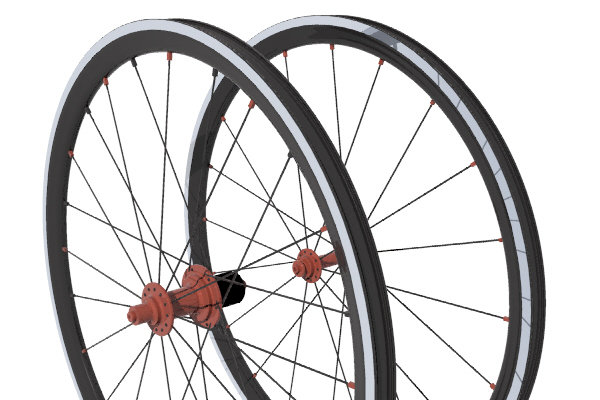

Creaks in Bicycles:
Finding and Fixing Them
by John Neugent
Tech articles | Commentary articles
The late John Neugent probably knew more about bicycle wheels than anyone else. Maybe more about bikes as well. He spent his life in the bike business, at every level. He owned Neugent Cycling, a firm devoted to delivering world-class equipment at the lowest possible price. —Chairman Bill

John Neugent

Les Woodland's book Tour de France: The Inside Story - Making the World's Greatest Bicycle Race is available as an audiobook here. For the print and Kindle eBook versions, just click on the Amazon link on the right.
John Neugent writes:
Creaks are one of the most annoying things that can happen on a bike. Now that many people are using carbon frames and wheels it has only made the matter worse. Carbon is such a good amplifier, it’s now used in guitars. Added to that is the fact that it’s often difficult or impossible to locate the cause of a creak because the sound can migrate.
Being in the wheel business, most of my experience is with wheel issues, but having been around bikes my whole life I have some experience with other components as well.
A creak is caused by two parts rubbing together. The solution is to lubricate that spot. A quick way to isolate the problem is to spray it with water. Water is a lubricant (and one of the best for rubber, which is a comforting thought on a rainy day). It doesn’t always work, but it’s fast and clean.
Many people think it’s their bearings creaking, but with wheels, that is almost never the case. Bottom bracket and headset bearings will creak, but not wheel bearings. In the case of the bottom bracket and headset bearings, it’s most likely the bearing seat that is moving and causing the problem and not the ball bearings themselves. Hub bearings have a tighter fit and are smaller bearings, so having the bearing seat move is extremely unusual.
On a wheel, the areas where the spokes cross are normally the problem, and one of the reasons I like to use a radial lacing pattern on all but the drive side rear wheel. Other possible trouble sites are the areas where the spokes enter the hub or rim. Less common but not uncommon are the skewer, axles (at the ends in the dropouts) and the cassette on the cassette body. I know some people grease everything up, even when they don’t need to, but grease attracts dirt so I wouldn’t do it unless I had to.

Wheels with radial lacing on all but the drive side
Other very common areas are the seat post, crankset (onto the bb spindle), pedals, cleats, headsets, and stems and handlebars.
Again, before you load your bike up with grease, spray some water on the different parts to see if you can detect a difference.
Ear plugs do work too but in my opinion, anything that blocks out the sound of the road is a safety issue. I know a lot of riders listen to music but to me you are taking out one of the key senses needed for safety.
Cycling is one of the pure experiences. That’s what attracts many of us. No motors, and simple gears (which the early race promoters thought were a form of cheating). Looking back it’s still very hard for me to believe the modern bicycle wasn’t invented until the mid 19th century – Washington, and most likely Lincoln had no knowledge of bikes. While it’s true Da Vinci made drawings, the concepts were not able to be made because the materials weren’t currently available (very much like Star Trek showing technologies that didn’t exist at the time).
Creaks infringe on the simplicity. A nagging noise. Like life, the solutions are not always easy, but you can get there with some patience and a spray bottle of water. One final thought, WD-40 is not your friend. It will penetrate and lube but only for a short time. You need real lube – a grease or thick oil. A grease, or thick oil (Phil Wood tenacious oil comes to mind) will hang around a lot longer.
And one final thought. I grew up on 3-in-1 oil. Luckily, it’s not found much anymore. But to us old folks, it’s really important that you understand what it is. When it was introduced in the early 20th Century, it was widely used for bicycle chains, and, put into internal gear hubs. In the early '70s I was a partner in a bike shop and when we opened an internal gear hub and saw a mass of brown corrosion, we knew it was because of 3-in-1 oil. It attracted moisture. WD-40 is fine as a temporary solution, but 3-in-1 should be avoided at all costs.
One final non-cycling comment. We hear creaks from our kids and kids hear it from their parents. We hear it from all parts of society. It’s no difference than on a bike, there are two parts sliding against each other creating friction and noise. The social lubrication is understanding each other.
Hard as it is to sort out what’s going on in the country, I never have a hard time with my cycling friends. I don’t care what their beliefs are – left or right. I do care about them – to the exclusion of their beliefs.
John Neugent was was one of the first to establish quality hand building in Taiwan around the turn of the century. He now owns Neugent Cycling, a firm devoted to delivering world-class equipment at the lowest possible price.







